University of Limerick Robes for History of Family
*The American Yawp is an evolving, collaborative text. Please click hither to amend this chapter.*
- I. Introduction
- II. Mail service-Civil War W Migration
- III. The Indian Wars and Federal Peace Policies
- IV. Across the Plains
- V. Western Economic Expansion: Railroads and Cattle
- VI. The Allotment Era and Resistance in the Native West
- 7. Rodeos, Wild West Shows, and the Mythic American West
- Eight. The West equally History: the Turner Thesis
- IX. Principal Sources
- 10. Reference Material
I. Introduction
Native Americans long dominated the vastness of the American West. Linked culturally and geographically by trade, travel, and warfare, diverse Ethnic groups controlled nigh of the continent w of the Mississippi River deep into the nineteenth century. Spanish, French, British, and later on American traders had integrated themselves into many regional economies, and American emigrants pushed ever due west, but no royal power had yet achieved anything approximating political or armed services control over the great bulk of the continent. But then the Civil War came and went and decoupled the Westward from the question of slavery merely as the United States industrialized and laid down runway and pushed its ever-expanding population e'er farther west.
Indigenous Americans have lived in Due north America for over ten millennia and, into the late nineteenth century, perhaps as many equally 250,000 Native people withal inhabited the American W.1 But then unending waves of American settlers, the American military, and the unstoppable onrush of American capital conquered all. Frequently in violation of its own treaties, the United States removed Native groups to e'er-shrinking reservations, incorporated the West first as territories and then as states, and, for the first fourth dimension in its history, controlled the enormity of state betwixt the two oceans.
The history of the late-nineteenth-century Westward is not a simple story. What some touted as a triumph—the due west expansion of American authority—was for others a tragedy. The W independent many peoples and many places, and their intertwined histories marked a pivotal transformation in the history of the U.s..
Ii. Post-Civil War Westward Migration
In the decades later on the Civil War, American settlers poured across the Mississippi River in tape numbers. No longer simply crossing over the continent for new imagined Edens in California or Oregon, they settled now in the vast heart of the continent.
Many of the start American migrants had come to the West in search of quick profits during the midcentury gold and silver rushes. Every bit in the California rush of 1848–1849, droves of prospectors poured in after precious-metal strikes in Colorado in 1858, Nevada in 1859, Idaho in 1860, Montana in 1863, and the Black Hills in 1874. While women often performed housework that immune mining families to subsist in often hard weather, a significant portion of the mining workforce were single men without families dependent on service industries in nearby towns and cities. There, working-grade women worked in shops, saloons, boardinghouses, and brothels. Many of these coincident operations profited from the mining blast: as failed prospectors institute, the rush itself frequently generated more wealth than the mines. The gilt that left Colorado in the beginning 7 years after the Pikes Peak gold strike—estimated at $25.5 million—was, for instance, less than half of what exterior parties had invested in the fever. The 100,000-plus migrants who settled in the Rocky Mountains were ultimately more valuable to the region's evolution than the gold they came to notice.ii
Others came to the Plains to extract the hides of the keen bison herds. Millions of animals had roamed the Plains, but their tough leather supplied industrial belting in eastern factories and raw fabric for the booming wear industry. Specialized teams took down and skinned the herds. The infamous American bison slaughter peaked in the early 1870s. The number of American bison plummeted from over 10 million at midcentury to only a few hundred by the early 1880s. The expansion of the railroads allowed ranching to replace the bison with cattle on the American grasslands.3
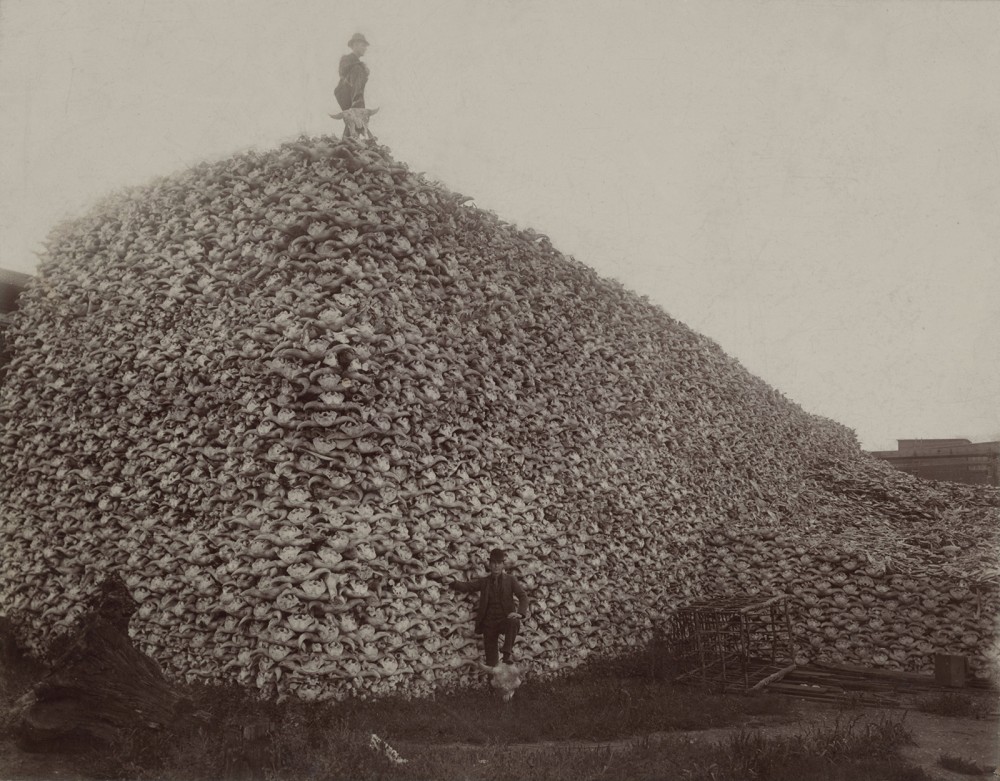
While bison supplied leather for America'southward booming clothing industry, the skulls of the animals also provided a key ingredient in fertilizer. This 1870s photograph illustrates the massive number of bison killed for these and other reasons (including sport) in the 2d half of the nineteenth century. Photograph of a pile of American bison skulls waiting to be ground for fertilizer, 1870s. Wikimedia.
The nearly 70 thousand members of the Church of Jesus Christ of Latter-Day Saints (more ordinarily chosen Mormons) who migrated west between 1846 and 1868 were similar to other Americans traveling west on the overland trails. They faced many of the aforementioned problems, but unlike nigh other American migrants, Mormons were fleeing from religious persecution.
Many historians view Mormonism every bit a "uniquely American faith," not merely because it was founded past Joseph Smith in New York in the 1830s, only because of its optimistic and future-oriented tenets. Mormons believed that Americans were exceptional—chosen by God to spread truth across the earth and to build utopia, a New Jerusalem in North America. Withal, many Americans were suspicious of the Latter-Day Saint movement and its unusual rituals, especially the practice of polygamy, and most Mormons plant it difficult to practice their religion in the eastern United States. Thus began a series of migrations in the midnineteenth century, first to Illinois, so Missouri and Nebraska, and finally into Utah Territory.
One time in the west, Mormon settlements served equally important supply points for other emigrants heading on to California and Oregon. Brigham Young, the leader of the Church building subsequently the death of Joseph Smith, was appointed governor of the Utah Territory past the federal government in 1850. He encouraged Mormon residents of the territory to engage in agronomical pursuits and be cautious of the outsiders who arrived equally the mining and railroad industries developed in the region.four
It was land, ultimately, that drew the most migrants to the Westward. Family farms were the courage of the agronomical economy that expanded in the Westward afterward the Ceremonious War. In 1862, northerners in Congress passed the Homestead Deed, which immune male citizens (or those who declared their intent to become citizens) to claim federally endemic lands in the West. Settlers could head westward, choose a 160-acre surveyed section of country, file a claim, and begin "improving" the land by plowing fields, edifice houses and barns, or earthworks wells, and, after 5 years of living on the country, could apply for the official championship deed to the land. Hundreds of thousands of Americans used the Homestead Act to learn country. The treeless plains that had been considered unfit for settlement became the new agronomical mecca for country-hungry Americans.five
The Homestead Deed excluded married women from filing claims because they were considered the legal dependents of their husbands. Some unmarried women filed claims on their own, but single farmers (male person or female person) were hard-pressed to run a farm and they were a small minority. Most farm households adopted traditional divisions of labor: men worked in the fields and women managed the dwelling house and kept the family fed. Both were essential.6
Migrants sometimes found in homesteads a self-sufficiency denied at home. 2nd or third sons who did not inherit country in Scandinavia, for instance, founded farm communities in Minnesota, Dakota, and other Midwestern territories in the 1860s. Boosters encouraged emigration by advert the semiarid Plains as, for example, "a flowery meadow of great fertility clothed in nutritious grasses, and watered past numerous streams."7 Western populations exploded. The Plains were transformed. In 1860, for example, Kansas had about 10,000 farms; in 1880 it had 239,000. Texas saw enormous population growth. The federal government counted 200,000 people in Texas in 1850, i,600,000 in 1880, and 3,000,000 in 1900, making it the sixth most populous state in the nation.
III. The Indian Wars and Federal Peace Policies
The "Indian wars," so mythologized in western sociology, were a series of seemingly sporadic, localized, and often brief engagements betwixt U.Due south. armed forces forces and various Native American groups. More than sustained and as impactful conflicts were economic and cultural. New patterns of American settlement, railroad construction, and material extraction clashed with the vast and cyclical movement across the Great Plains to hunt buffalo, raid enemies, and merchandise goods. Thomas Jefferson'due south former dream that Ethnic nations might alive isolated in the W was, in the face up of American expansion, no longer a viable reality. Political, economical, and even humanitarian concerns intensified American efforts to isolate Indians on reservations. Although Indian removal had long been a part of federal Indian policy, following the Civil War the U.S. government redoubled its efforts. If treaties and other forms of persistent coercion would not work, federal officials pushed for more drastic measures: after the Civil State of war, coordinated war machine action past celebrity Civil War generals such every bit William Sherman and William Sheridan exploited and exacerbated local conflicts sparked by illegal business ventures and settler incursions. Against the threat of solitude and the extinction of traditional ways of life, Native Americans battled the American army and the encroaching lines of American settlement.
In i of the earliest western engagements, in 1862, while the Civil State of war still consumed the Us, tensions erupted between Dakota Nation and white settlers in Minnesota and the Dakota Territory. The 1850 U.S. census recorded a white population of about 6,000 in Minnesota; eight years later on, when it became a state, it was more than than 150,000.8 The illegal influx of American farmers pushed the Dakota to the breaking betoken. Hunting became unsustainable and those Dakota who had taken up farming plant simply poverty. The federal Indian agent refused to disburse promised food. Many starved. Andrew Myrick, a trader at the bureau, refused to sell nutrient on credit. "If they are hungry," he is alleged to have said, "permit them swallow grass or their own dung." And so, on Baronial 17, 1862, four young men of the Santees, a Dakota ring, killed five white settlers about the Redwood Agency, an American administrative office. In the face of an inevitable American retaliation, and over the protests of many members, the tribe chose war. On the post-obit day, Dakota warriors attacked settlements near the Agency. They killed thirty-one men, women, and children (including Myrick, whose rima oris was found filled with grass). They so ambushed a U.Southward. armed forces detachment at Redwood Ferry, killing twenty-three. The governor of Minnesota called upwards militia and several thousand Americans waged war confronting the Sioux insurgents. Fighting broke out at New Ulm, Fort Ridgely, and Birch Coulee, but the Americans bankrupt the Indian resistance at the Battle of Woods Lake on September 23, catastrophe the so-called Dakota War.9
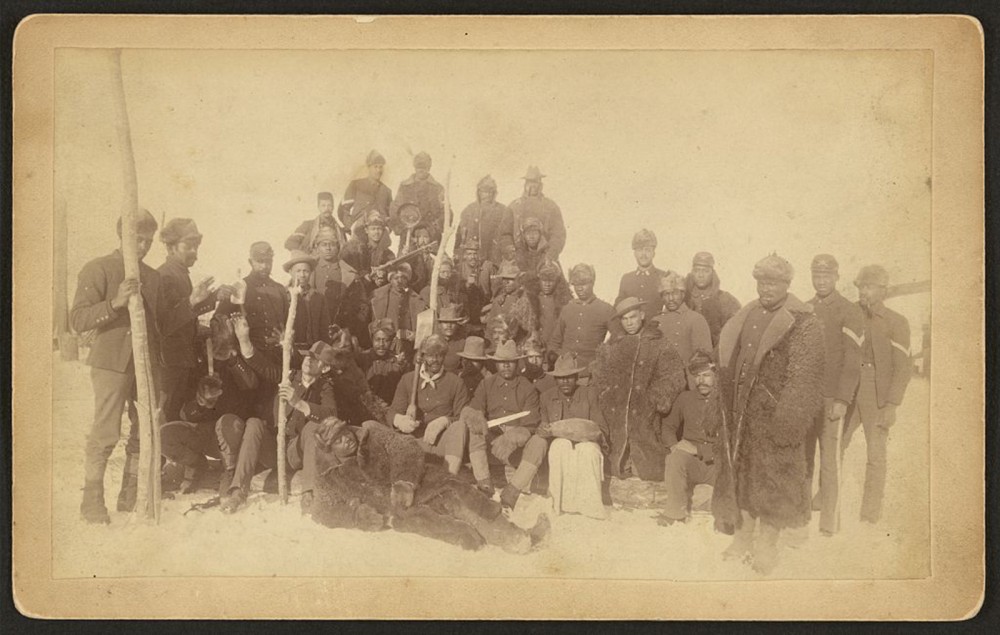
Buffalo Soldiers, the nickname given to African-American cavalrymen by the native Americans they fought, were the commencement peacetime all-black regiments in the regular United States regular army. These soldiers regularly confronted racial prejudice from other Army members and civilians just were an essential part of American victories during the Indian Wars of the late nineteenth and early twentieth centuries. "[Buffalo soldiers of the 25th Infantry, some wearing buffalo robes, Ft. Keogh, Montana] / Chr. Barthelmess, photographer, Fort Keogh, Montana," 1890. Library of Congress.
More than ii yard Dakota had been taken prisoner during the fighting. Many were tried at federal forts for murder, rape, and other atrocities, in a kind of legalistic choreography that conveyed American ideas of Native guilt and white innocence. Military tribunals convicted 303 Dakota and sentenced them to hang. At the last minute, President Lincoln commuted all only xxx-eight of the sentences. Minnesota settlers and government officials insisted not only that the Dakota lose much of their reservation lands and be removed farther west, simply that those who had fled exist hunted down and placed on reservations as well. The American military gave chase and, on September iii, 1863, afterwards a year of compunction, American military units surrounded a large encampment of Dakota. American troops killed an estimated three hundred men, women, and children. Dozens more were taken prisoner. Troops spent the next two days burning winter food and supply stores to starve out the Dakota resistance, which continued to insist on Dakota sovereignty and treaty rights.
Farther south, settlers inflamed tensions in Colorado. In 1851, the commencement Treaty of Fort Laramie had secured right-of-way access for Americans passing through on their way to California and Oregon. But a gilded rush in 1858 drew approximately 100,000 white gilt seekers, and they demanded new treaties exist fabricated with local Indian groups to secure land rights in the newly created Colorado Territory. Cheyenne bands splintered over the possibility of signing a new treaty that would confine them to a reservation. Settlers, already wary of raids by powerful groups of Cheyennes, Arapahos, and Comanches, meanwhile read in their local newspapers sensationalist accounts of the uprising in Minnesota. Militia leader John Thou. Chivington warned settlers in the summer of 1864 that the Cheyenne were dangerous, urged war, and promised a swift military machine victory. Settlers sparked conflict and sporadic fighting bankrupt out. The anile Cheyenne chief Black Kettle, believing that a peace treaty would be all-time for his people, traveled to Denver to arrange for peace talks. He and his followers traveled toward Fort Lyon in accord with authorities instructions, simply on November 29, 1864, Chivington ordered his seven hundred militiamen to move on the Cheyenne camp near Fort Lyon at Sand Creek. The Cheyenne tried to declare their peaceful intentions just Chivington's militia cut them down. It was a slaughter. Chivington's men killed 2 hundred men, women, and children.10 The Sand Creek Massacre was a national scandal, alternately condemned and applauded.
As settler incursions continued to provoke disharmonize, Americans pushed for a new "peace policy." Congress, confronted with these tragedies and farther violence, authorized in 1868 the creation of an Indian Peace Commission. The commission'southward study of American Indians decried prior American policy and galvanized support for reformers. Subsequently the inauguration of Ulysses S. Grant the following leap, Congress allied with prominent philanthropists to create the Board of Indian Commissioners, a permanent advisory body to oversee Indian diplomacy and prevent the further outbreak of violence. The board effectively Christianized American Indian policy. Much of the reservation system was handed over to Protestant churches, which were tasked with finding agents and missionaries to manage reservation life. Congress hoped that religiously minded men might fare meliorate at creating merely assimilation policies and persuading Indians to accept them. Historian Francis Paul Prucha believed that this attempt at a new "peace policy . . . might merely take properly been labelled the 'religious policy.'"xi
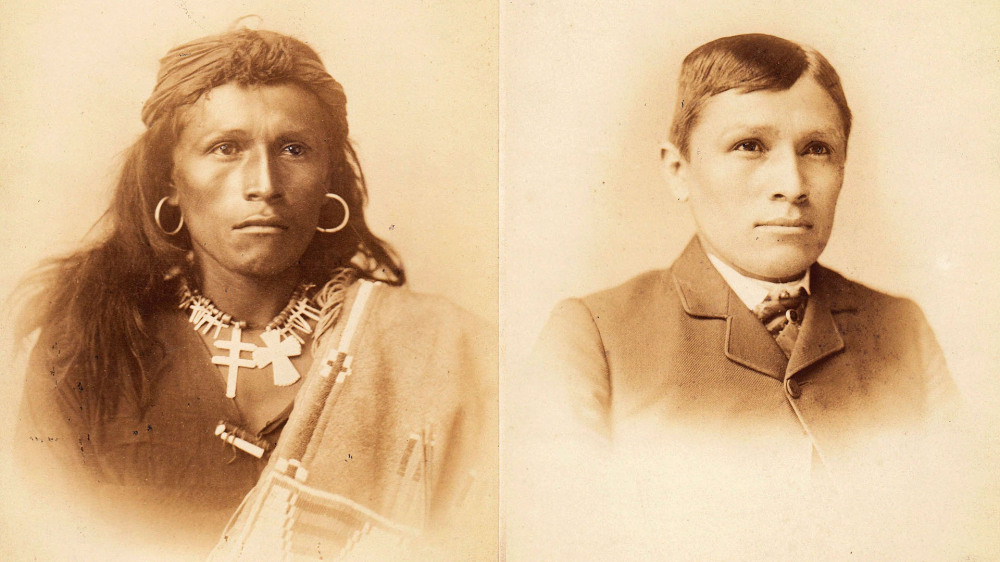
Tom Torlino, a member of the Navajo Nation, entered the Carlisle Indian Schoolhouse, a Native American boarding school founded by the U.s. regime in 1879, on Oct 21, 1882 and departed on Baronial 28, 1886. Torlino's educatee file contained photographs from 1882 and 1885. Carlisle Indian School Digital Resource Center.
Many female person Christian missionaries played a central role in cultural reeducation programs that attempted to non only instill Protestant organized religion but also impose traditional American gender roles and family structures. They endeavored to supplant Indians' tribal social units with small, patriarchal households. Women'south labor became a contentious issue because few tribes divided labor according to the gender norms of middle- and upper-class Americans. Fieldwork, the traditional domain of white males, was primarily performed past Native women, who besides usually controlled the products of their labor, if not the land that was worked, giving them status in society as laborers and food providers. For missionaries, the goal was to get Native women to leave the fields and engage in more proper "women'south" work—housework. Christian missionaries performed much as secular federal agents had. Few American agents could run across Native Americans on their ain terms. Near viewed reservation Indians as lazy and thought of Native cultures equally inferior to their own. The views of J. L. Broaddus, appointed to oversee several modest Indian tribes on the Hoopa Valley reservation in California, are illustrative: in his annual report to the Commissioner of Indian Affairs for 1875, he wrote, "The great bulk of them are idle, listless, careless, and improvident. They seem to have no thought about provision for the hereafter, and many of them would not work at all if they were not compelled to do so. They would rather live upon the roots and acorns gathered by their women than to piece of work for flour and beef."12
If the Indians could not exist forced through kindness to modify their means, most agreed that it was acceptable to use force, which Native groups resisted. In Texas and the Southern Plains, the Comanche, the Kiowa, and their allies had wielded enormous influence. The Comanche in particular controlled huge swaths of territory and raided vast areas, inspiring terror from the Rocky Mountains to the interior of northern Mexico to the Texas Gulf Coast. Merely afterwards the Civil State of war, the U.South. military refocused its attending on the Southern Plains.
The American military first sent messengers to the Plains to notice the elusive Comanche bands and ask them to come to peace negotiations at Medicine Order Creek in the autumn of 1867. Simply terms were muddled: American officials believed that Comanche bands had accustomed reservation life, while Comanche leaders believed they were guaranteed vast lands for buffalo hunting. Comanche bands used designated reservation lands equally a base from which to collect supplies and federal annuity goods while standing to hunt, trade, and raid American settlements in Texas.
Confronted with renewed Comanche raiding, particularly by the famed war leader Quanah Parker, the U.S. military machine finally proclaimed that all Indians who were non settled on the reservation past the fall of 1874 would be considered "hostile." The Red River War began when many Comanche bands refused to resettle and the American military launched expeditions into the Plains to subdue them, culminating in the defeat of the remaining roaming bands in the canyonlands of the Texas Panhandle. Cold and hungry, with their way of life already decimated by soldiers, settlers, cattlemen, and railroads, the last gratis Comanche bands were moved to the reservation at Fort Sill, in what is now southwestern Oklahoma.thirteen
On the northern Plains, the Sioux people had yet to fully surrender. Following the military defeats of 1862, many bands had signed treaties with the The states and drifted into the Ruby-red Cloud and Spotted Tail agencies to collect rations and annuities, only many continued to resist American encroachment, particularly during Ruby-red Deject's War, a rare victory for the Plains people that resulted in the Treaty of 1868 and created the Great Sioux Reservation. Then, in 1874, an American expedition to the Blackness Hills of South Dakota discovered golden. White prospectors flooded the territory. Caring very little well-nigh Indian rights and very much almost getting rich, they brought the Sioux situation again to its breaking betoken. Enlightened that U.S. citizens were violating treaty provisions, but unwilling to prevent them from searching for golden, federal officials pressured the western Sioux to sign a new treaty that would transfer control of the Black Hills to the United States while General Philip Sheridan quietly moved U.S. troops into the region. Initial clashes between U.S. troops and Sioux warriors resulted in several Sioux victories that, combined with the visions of Sitting Bull, who had dreamed of an even more triumphant victory, attracted Sioux bands who had already signed treaties but at present joined to fight.14
In belatedly June 1876, a division of the seventh Cavalry Regiment led by Lieutenant Colonel George Armstrong Custer was sent up a trail into the Black Hills equally an advance baby-sit for a larger force. Custer's men approached a camp along a river known to the Sioux every bit Greasy Grass but marked on Custer'south map equally Lilliputian Bighorn, and they found that the influx of "treaty" Sioux as well equally aggrieved Cheyenne and other allies had swelled the population of the village far across Custer'southward estimation. Custer's 7th Cavalry was vastly outnumbered, and he and 268 of his men were killed.15
Custer's fall shocked the nation. Cries for a swift American response filled the public sphere, and military expeditions were sent out to crush Native resistance. The Sioux splintered off into the wilderness and began a campaign of intermittent resistance but, outnumbered and suffering later a long, hungry winter, Crazy Horse led a ring of Oglala Sioux to surrender in May 1877. Other bands gradually followed until finally, in July 1881, Sitting Bull and his followers at last laid down their weapons and came to the reservation. Indigenous powers had been defeated. The Plains, it seemed, had been pacified.
IV. Across the Plains
Plains peoples were not the only ones who suffered equally a result of American expansion. Groups like the Utes and Paiutes were pushed out of the Rocky Mountains by U.South. expansion into Colorado and away from the northern Keen Bowl past the expanding Mormon population in Utah Territory in the 1850s and 1860s. Faced with a shrinking territorial base, members of these two groups oft joined the U.South. military in its campaigns in the southwest against other powerful Native groups like the Hopi, the Zuni, the Jicarilla Apache, and especially the Navajo, whose population of at least 10 yard engaged in both farming and sheep herding on some of the most valuable lands acquired by the United States after the Mexican War.
Conflicts between the U.South. war machine, American settlers, and Native nations increased throughout the 1850s. Past 1862, General James Carleton began searching for a reservation where he could remove the Navajo and end their threat to U.Southward. expansion in the Southwest. Carleton selected a dry out, almost treeless site in the Bosque Redondo Valley, iii hundred miles from the Navajo homeland.
In Apr 1863, Carleton gave orders to Colonel Kit Carson to round up the unabridged Navajo population and escort them to Bosque Redondo. Those who resisted would be shot. Thus began a period of Navajo history chosen the Long Walk, which remains deeply of import to Navajo people today. The Long Walk was not a single event but a series of forced marches to the reservation at Bosque Redondo between August 1863 and December 1866. Conditions at Bosque Redondo were horrible. Provisions provided by the U.Southward. Army were not only inadequate merely often spoiled; disease was rampant, and thousands of Navajos died.
By 1868, information technology had become clear that life at the reservation was unsustainable. Full general William Tecumseh Sherman visited the reservation and wrote of the inhumane situation in which the Navajo were essentially kept as prisoners, but lack of cost-effectiveness was the main reason Sherman recommended that the Navajo exist returned to their homeland in the Due west. On June ane, 1868, the Navajo signed the Treaty of Bosque Redondo, an unprecedented treaty in the history of U.S.-Indian relations in which the Navajo were able to return from the reservation to their homeland.
The attacks on Native nations in California and the Pacific Northwest received significantly less attention than the dramatic conquest of the Plains, but Native peoples in these regions also experienced violence, population reject, and territorial loss. For case, in 1872, the California/Oregon border erupted in violence when the Modoc people left the reservation of the Klamath Nation, onto which they had been forced, and returned to their homelands in an area known as Lost River. Americans had settled the region after Modoc removal several years earlier, and they complained bitterly of the Natives' render. The U.Southward. military arrived when 50-2 remaining Modoc warriors, led by Kintpuash, known to settlers every bit Captain Jack, refused to render to the reservation and holed up in defensive positions along the state border. They fought a guerrilla war for eleven months in which at least 2 hundred U.S. troops were killed before they were finally forced to give up. Despite appeals from settlers acquainted with the Modoc, the federal government hanged Kintpuash and iii others leaders in a highly choreographed and publicized public execution.xvi
Four years subsequently, in the Pacific Northwest, a branch of the Nez Perce (who, generations earlier, had aided Lewis and Clark in their famous journey to the Pacific Ocean) refused to be moved to a reservation and, under the leadership of Hin-mah-as well-yah-lat-kekt, known to settlers and American readers equally Chief Joseph, attempted to flee to Canada but were pursued past the U.South. Cavalry. The outnumbered Nez Perce battled across a yard miles and were attacked about two dozen times before they succumbed to hunger and exhaustion, surrendered, were imprisoned, and removed to a reservation in Indian Territory. The flying of the Nez Perce captured the attention of the U.s.a., and a transcript of Chief Joseph'south surrender, as allegedly recorded by a U.S. Army officeholder, became a landmark of American rhetoric. "Hear me, my chiefs," Joseph was supposed to accept said, "I am tired. My heart is sick and lamentable. From where the sunday now stands, I volition fight no more forever." Main Joseph used his celebrity, and, after several years, negotiated his people's relocation to a reservation nearer to their historic home.17
The treaties that had been signed with numerous Native nations in California in the 1850s were never ratified past the Senate. Over one hundred distinct Native groups had lived in California before the Castilian and American conquests, but by 1880, the Native population of California had collapsed from about 150,000 on the eve of the gold rush to a footling less than 20,000. A few reservation areas were somewhen prepare up by the U.S. government to collect what remained of the Native population, only most were dispersed throughout California. This was partly the consequence of state laws from the 1850s that allowed white Californians to obtain both Native children and adults as "apprentice" laborers past merely bringing the desired laborer before a judge and promising to feed, clothe, and somewhen release them after a menstruation of "service" that ranged from ten to twenty years. Thousands of California's Natives were thus pressed into a form of slave labor that supported the growing mining, agricultural, railroad, and cattle industries.
V. Western Economical Expansion: Railroads and Cattle
Aside from agriculture and the extraction of natural resource—such as timber and precious metals—two major industries fueled the new western economy: ranching and railroads. Both adult in connection with each other, accelerated the inrush of settlers displacing Native peoples out, and shaped the collective American retentiveness of the mail–Civil State of war "Wild West."
As i booster put it, "the Westward is purely a railroad enterprise." No economical enterprise rivaled the railroads in calibration, scope, or sheer impact. No other businesses had attracted such enormous sums of capital, and no other ventures ever received such lavish government subsidies (business organization historian Alfred Chandler called the railroads the "showtime modern business enterprise").18 Past "annihilating fourth dimension and space"—by connecting the vastness of the continent—the railroads transformed the United States and fabricated the American Due west.
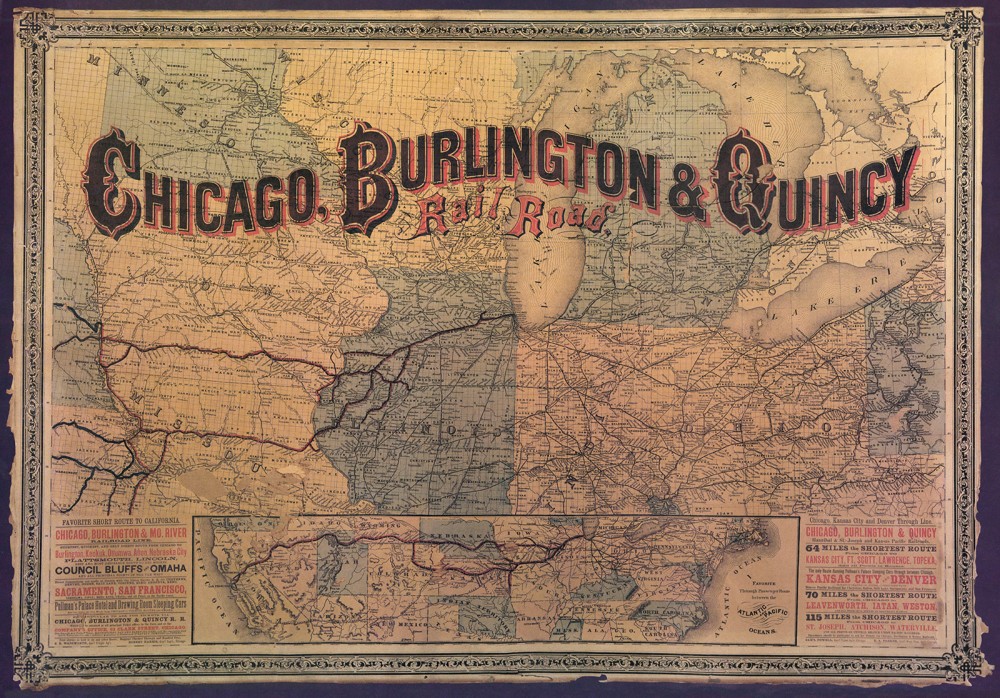
Railroads made the settlement and growth of the Due west possible. Past the belatedly nineteenth century, maps of the Midwest were filled with advertisements touting how quickly a traveler could traverse the country. The Environment and Society Portal, a digital project from the Rachel Carson Eye for Surround and Society, a joint initiative of LMU Munich and the Deutsches Museum.
No railroad enterprise so captured the American imagination—or federal support—as the transcontinental railroad. The transcontinental railroad crossed western plains and mountains and linked the W Coast with the track networks of the eastern U.s.a.. Constructed from the westward past the Cardinal Pacific and from the east by the Marriage Pacific, the two roads were linked in Utah in 1869 to bang-up national fanfare. But such a herculean task was not easy, and national legislators threw enormous subsidies at railroad companies, a role of the Republican Party platform since 1856. The 1862 Pacific Railroad Act gave bonds of betwixt $16,000 and $48,000 for each mile of construction and provided vast land grants to railroad companies. Between 1850 and 1871 lonely, railroad companies received more than 175,000,000 acres of public state, an area larger than the country of Texas. Investors reaped enormous profits. As one congressional opponent put it in the 1870s, "If at that place exist profit, the corporations may accept it; if there be loss, the Government must bear it."xix
If railroads attracted unparalleled subsidies and investments, they also created enormous labor demands. By 1880, approximately four hundred thousand men—or nigh two.five per centum of the nation's entire workforce—labored in the railroad manufacture. Much of the work was unsafe and low-paying, and companies relied heavily on immigrant labor to build tracks. Companies employed Irish workers in the early nineteenth century and Chinese workers in the belatedly nineteenth century. By 1880, over two hundred thousand Chinese migrants lived in the U.s.. Once the rails were laid, companies nevertheless needed a large workforce to proceed the trains running. Much railroad work was unsafe, but perhaps the most hazardous work was done by brakemen. Before the advent of automated braking, an engineer would blow the "down brake" whistle and brakemen would scramble to the top of the moving train, regardless of the weather conditions, and run from motorcar to car manually turning brakes. Speed was necessary, and any slip could exist fatal. Brakemen were likewise responsible for coupling the cars, attaching them together with a large pin. It was like shooting fish in a barrel to lose a paw or finger and fifty-fifty a slight mistake could cause cars to collide.twenty
The railroads boomed. In 1850, there were nine,000 miles of railroads in the United States. In 1900 there were 190,000, including several transcontinental lines.21 To manage these vast networks of freight and passenger lines, companies converged rails at hub cities. Of all the Midwestern and western cities that blossomed from the bridging of western resources and eastern uppercase in the late nineteenth century, Chicago was the about spectacular. Information technology grew from two hundred inhabitants in 1833 to over a million by 1890. By 1893 it and the region from which information technology drew were completely transformed. The Globe's Columbian Exposition that twelvemonth trumpeted the city'south progress and broader technological progress, with typical Gilded Age ostentation. A huge, gleaming (simply temporary) "White City" was congenital in neoclassical mode to house all the features of the fair and cater to the needs of the visitors who arrived from all over the world. Highlighted in the title of this world's off-white were the changes that had overtaken North America since Columbus made landfall four centuries earlier. Chicago became the nearly of import western hub and served as the gateway between the subcontract and ranch country of the Keen Plains and eastern markets. Railroads brought cattle from Texas to Chicago for slaughter, where they were then candy into packaged meats and shipped by refrigerated rail to New York City and other eastern cities. Such hubs became the cardinal nodes in a rapid-transit economy that increasingly spread across the entire continent linking appurtenances and people together in a new national network.
This national network created the fabled cattle drives of the 1860s and 1870s. The offset cattle drives across the primal Plains began soon subsequently the Civil War. Railroads created the market for ranching, and for the few years after the war that railroads connected eastern markets with important market hubs such as Chicago, but had yet to reach Texas ranchlands, ranchers began driving cattle n, out of the Lone Star state, to major railroad terminuses in Kansas, Missouri, and Nebraska. Ranchers used well-worn trails, such as the Chisholm Trail, for drives, but conflicts arose with Native Americans in the Indian Territory and farmers in Kansas who disliked the intrusion of large and environmentally subversive herds onto their ain hunting, ranching, and farming lands. Other trails, such as the Western Trail, the Goodnight-Loving Trail, and the Shawnee Trail, were therefore blazed.
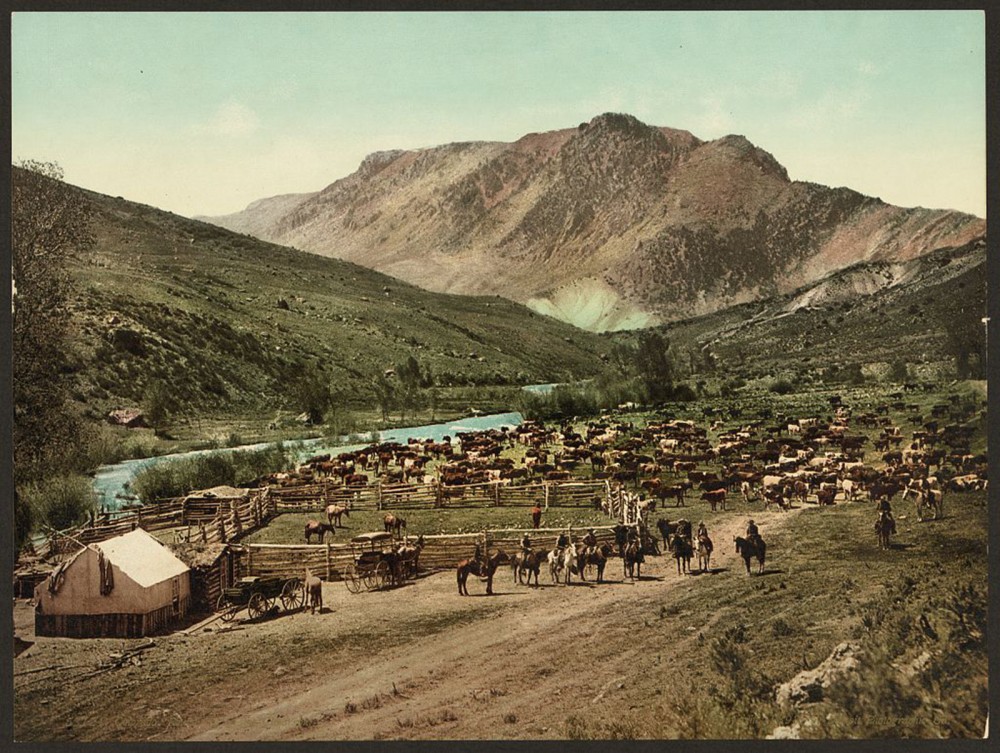
This photochrom print (a new engineering in the belatedly nineteenth century that colorized images from a blackness-and-white negative) depicts a cattle round-up in Cimarron, a crossroads of the late nineteenth-century cattle drives. Detroit Photographic Co., "Colorado. 'Round up' on the Cimarron," c. 1898. Library of Congress.
Cattle drives were difficult tasks for the crews of men who managed the herds. Historians gauge the number of men who worked as cowboys in the late-nineteenth century to exist between twelve thousand and forty yard. Mayhap a fourth were African American, and more were likely Mexican or Mexican American. Much well-nigh the American cowboys evolved from Mexican vaqueros: cowboys adopted Mexican practices, gear, and terms such as rodeo, bronco, and lasso."
While nearly cattle drivers were men, there are at least sixteen verifiable accounts of women participating in the drives. Some, like Molly Dyer Goodnight, accompanied their husbands. Others, similar Lizzie Johnson Williams, helped drive their own herds. Williams made at least three known trips with her herds up the Chisholm Trail.
Many cowboys hoped i day to become ranch owners themselves, simply employment was insecure and wages were low. Beginners could expect to earn effectually $20–$25 per calendar month, and those with years of experience might earn $40–$45. Trail bosses could earn over $fifty per calendar month. And it was tough work. On a cattle drive, cowboys worked long hours and faced extremes of heat and common cold and intense blowing dust. They subsisted on limited diets with irregular supplies.22
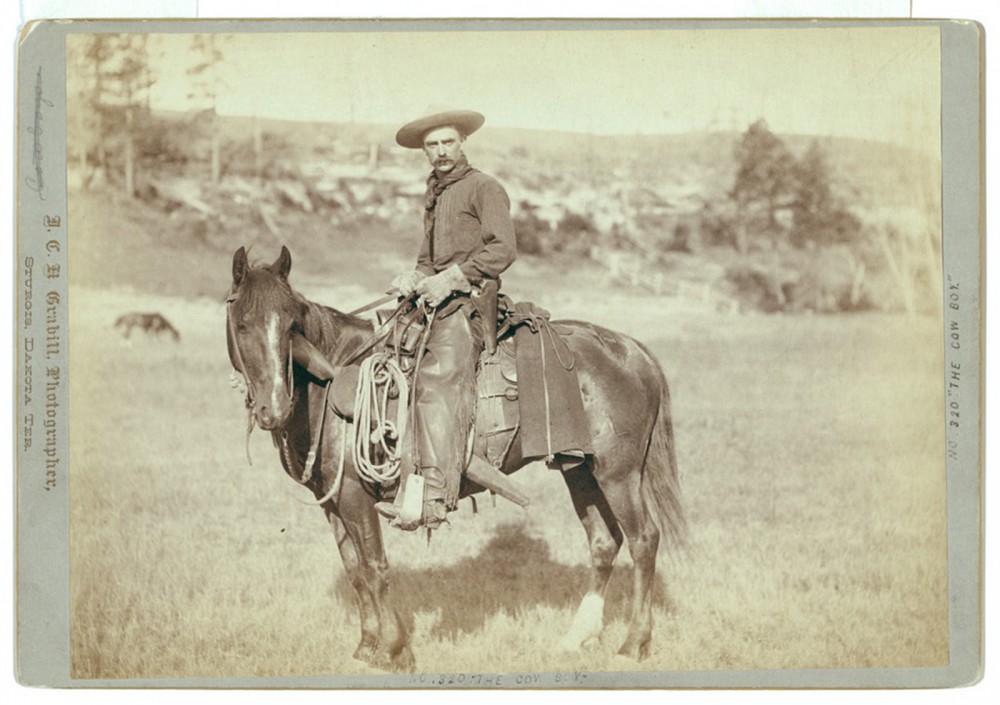
Cowboys like the 1 pictured here worked the drives that supplied Chicago and other mid-western cities with the necessary cattle to supply and help grow the meat-packing industry. Their work was obsolete by the turn of the century, yet their image lived on through vaudeville shows and films that romanticized life in the West. John C.H. Grabill, "The Cow Boy," c. 1888. Library of Congress.
But if workers of cattle earned low wages, owners and investors could receive riches. At the end of the Civil State of war, a steer worth $iv in Texas could fetch $40 in Kansas. Although profits slowly leveled off, large profits could still be made. And yet, by the 1880s, the great cattle drives were largely washed. The railroads had created them, and the railroads ended them: railroad lines pushed into Texas and fabricated the keen drives obsolete. But ranching nonetheless brought profits and the Plains were better suited for grazing than for agronomics, and western ranchers continued supplying beefiness for national markets.
Ranching was merely one of many western industries that depended on the railroads. By linking the Plains with national markets and rapidly moving people and appurtenances, the railroads made the modern American West.
VI. The Allotment Era and Resistance in the Native West
As the rails moved into the West, and more and more than Americans followed, the situation for Native groups deteriorated even further. Treaties negotiated betwixt the U.s.a. and Native groups had typically promised that if tribes agreed to move to specific reservation lands, they would hold those lands collectively. But as American due west migration mounted and open lands closed, white settlers began to fence that Native people had more their off-white share of land, that the reservations were too large, that Native people were using the land "inefficiently," and that they still preferred nomadic hunting instead of intensive farming and ranching.
Past the 1880s, Americans increasingly championed legislation to allow the transfer of indigienous lands to farmers and ranchers, while many argued that allotting country to private Native Americans, rather than to tribes, would encourage American-style agriculture and finally put Indians who had previously resisted the efforts of missionaries and federal officials on the path to "civilization."
Passed by Congress on February 8, 1887, the Dawes General Allotment Act splintered Native American reservations into private family unit homesteads. Each head of a Native family was to exist allotted 160 acres, the typical size of a claim that any settler could institute on federal lands under the provisions of the Homestead Act. Single individuals over age eighteen would receive an eighty-acre allotment, and orphaned children received twoscore acres. A four-year timeline was established for Indian peoples to make their resource allotment selections. If at the end of that time no pick had been made, the act authorized the secretary of the interior to appoint an amanuensis to make selections for the remaining tribal members. Allegedly to protect Indians from existence swindled by unscrupulous land speculators, all allotments were to be held in trust—they could not be sold by allottees—for twenty-five years. Lands that remained unclaimed by tribal members after allotment would revert to federal command and exist sold to American settlers.23
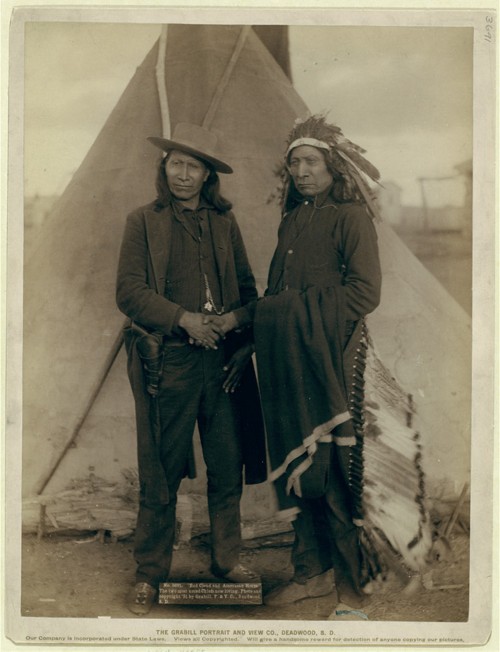
Red Cloud and American Horse – ii of the nigh renowned Ogala chiefs – are seen clasping easily in front of a tipi on the Pino Ridge Reservation in Southward Dakota. Both men served every bit delegates to Washington, D.C., after years of actively fighting the American government. John C. Grabill, "'Red Deject and American Horse.' The two most noted chiefs now living," 1891. Library of Congress.
Americans touted the Dawes Act equally an uplifting humanitarian reform, but it upended Native lifestyles and left Native nations without sovereignty over their lands. The act claimed that to protect Native property rights, it was necessary to extend "the protection of the laws of the United states of america . . . over the Indians." Tribal governments and legal principles could be superseded, or dissolved and replaced, by U.S. laws. Under the terms of the Dawes Act, Native nations struggled to agree on to some measure of tribal sovereignty.
The stresses of conquest unsettled generations of Native Americans. Many took comfort from the words of prophets and holy men. In Nevada, on January 1, 1889, Northern Paiute prophet Wovoka experienced a great revelation. He had traveled, he said, from his earthly home in western Nevada to heaven and returned during a solar eclipse to prophesy to his people. "Y'all must not hurt anybody or exercise harm to anyone. You must non fight. Exercise right always," he allegedly exhorted. And they must, he said, participate in a religious ceremony that came to exist known as the Ghost Trip the light fantastic. If the people lived justly and danced the Ghost Trip the light fantastic, Wovoka said, their ancestors would rising from the expressionless, droughts would misemploy, the whites in the W would vanish, and the buffalo would one time again roam the Plains.24
Native American prophets had often confronted American royal power. Some prophets, including Wovoka, incorporated Christian elements like heaven and a Messiah figure into Indigenous spiritual traditions. And so, though it was far from unique, Wovoka'south prophecy nevertheless caught on quickly and spread across the Paiutes. From beyond the West, members of the Arapaho, Bannock, Cheyenne, and Shoshone nations, amid others, adopted the Ghost Trip the light fantastic organized religion. Perchance the well-nigh avid Ghost Dancers—and certainly the about famous—were the Lakota Sioux.
The Lakota were in dire straits. South Dakota, formed out of land that belonged by treaty to the Lakota, became a land in 1889. White homesteaders had poured in, reservations were carved upwards and diminished, starvation set in, corrupt federal agents cut nutrient rations, and drought hit the Plains. Many Lakota feared a future equally the landless subjects of a growing American empire when a delegation of eleven men, led by Kicking Bear, joined Ghost Trip the light fantastic toe pilgrims on the rails w to Nevada and returned to spread the revival in the Dakotas.
The energy and message of the revivals frightened settlers and Indian agents. Newly arrived Pino Ridge agent Daniel Royer sent fearful dispatches to Washington and the printing urging a military crackdown. Newspapers, meanwhile, sensationalized the Ghost Dance.25 Agents began absorbing Lakota leaders. Chief Sitting Balderdash and several others were killed in December 1890 during a botched abort, convincing many bands to flee the reservations to join fugitive bands farther w, where Lakota adherents of the Ghost Dance preached that the Ghost Dancers would be immune to bullets.
Two weeks later, an American cavalry unit intercepted a band of 350 Lakotas, including over 100 women and children, nether Chief Spotted Elk (afterward known every bit Bigfoot) seeking refuge at the Pine Ridge Agency. They were escorted to Wounded Genu Creek, where they camped for the night. The following morning, December 29, the American cavalrymen entered the campsite to disarm Spotted Elk'due south band. Tensions flared, a shot was fired, and a skirmish became a massacre. The Americans fired their heavy weaponry indiscriminately into the camp. 2 dozen cavalrymen had been killed by the Lakotas' concealed weapons or by friendly fire, but when the guns went silent, between 150 and 300 Native men, women, and children were dead.26
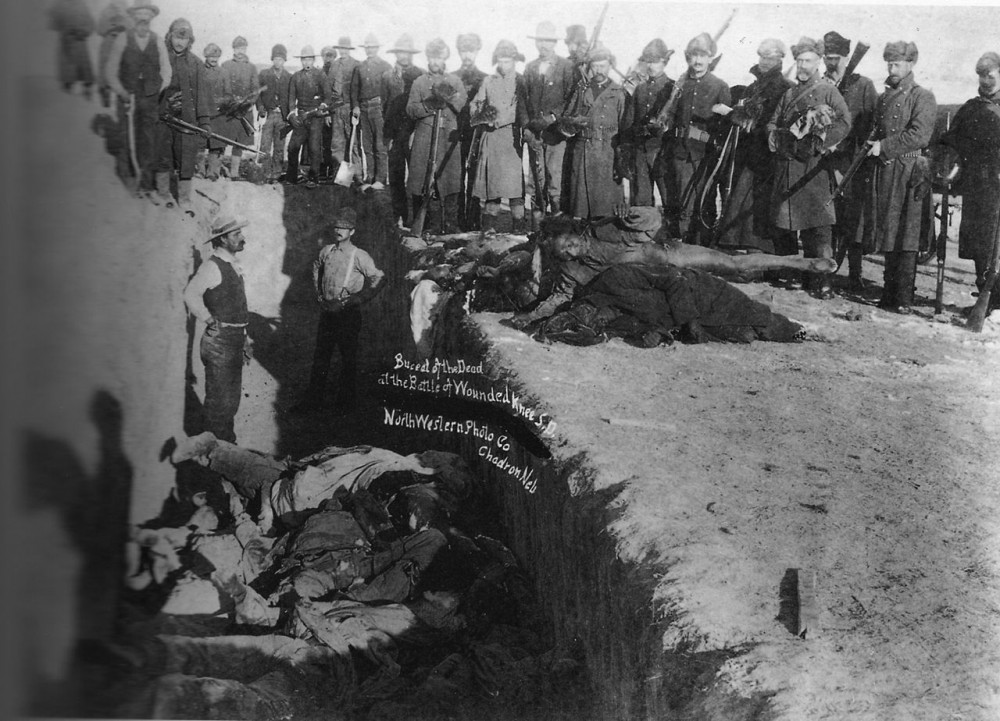
Burial of the dead after the massacre of Wounded Knee. U.S. Soldiers putting Indians in common grave; some corpses are frozen in dissimilar positions. South Dakota. 1891. Library of Congress.
Wounded Knee joint marked the end of sustained, armed Native American resistance on the Plains. Individuals continued to resist the pressures of assimilation and preserve traditional cultural practices, but sustained military defeats, the loss of sovereignty over country and resources, and the onset of crippling poverty on the reservations marked the final decades of the nineteenth century every bit a particularly night era for America's western tribes. Only for Americans, it became mythical.
7. Rodeos, Wild West Shows, and the Mythic American Due west
"The American West" conjures visions of tipis, cabins, cowboys, Indians, subcontract wives in sunbonnets, and outlaws with half dozen-shooters. Such images pervade American culture, but they are every bit old every bit the West itself: novels, rodeos, and Wild W shows mythologized the American W throughout the post–Civil War era.
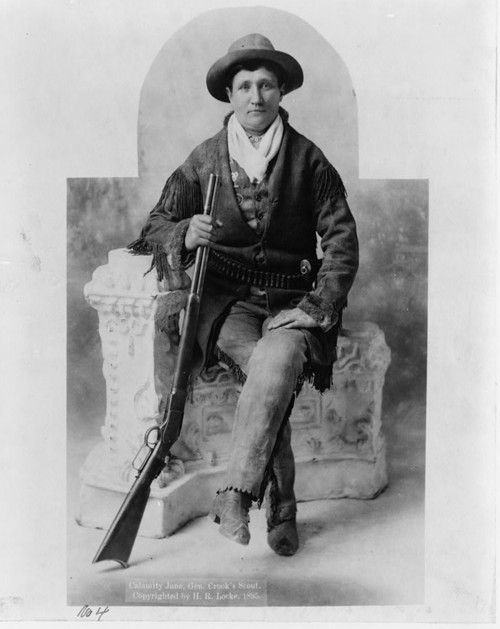
American frontierswoman and professional scout Martha Jane Canary was meliorate known to America every bit Calamity Jane. A figure in western folklore during her life and after, Calamity Jane was a key character in many of the increasingly popular novels and films that romanticized western life in the twentieth century. "[Martha Canary, 1852-1903, ("Calamity Jane"), full-length portrait, seated with burglarize every bit Full general Crook's picket]," c. 1895. Library of Congress.
In the 1860s, Americans devoured dime novels that embellished the lives of existent-life individuals such as Calamity Jane and Billy the Kid. Owen Wister's novels, especially The Virginian, established the character of the cowboy as a gritty stoic with a rough exterior but the backbone and heroism needed to rescue people from railroad train robbers, Indians, and cattle rustlers. Such images were later reinforced when the emergence of rodeo added to popular conceptions of the American Westward. Rodeos began equally small roping and riding contests amid cowboys in towns almost ranches or at camps at the terminate of the cattle trails. In Pecos, Texas, on July 4, 1883, cowboys from two ranches, the Hash Knife and the W Ranch, competed in roping and riding contests equally a style to settle an argument; this event is recognized past historians of the West equally the first existent rodeo. Coincidental contests evolved into planned celebrations. Many were scheduled around national holidays, such as Independence Day, or during traditional roundup times in the jump and fall. Early rodeos took place in open grassy areas—not arenas—and included dogie and steer roping and roughstock events such equally bronc riding. They gained popularity and soon dedicated rodeo circuits developed. Although near 90 percent of rodeo contestants were men, women helped popularize the rodeo and several pop female bronc riders, such every bit Bertha Kaepernick, entered men's events, until around 1916 when women'southward competitive participation was curtailed. Americans as well experienced the "Wild West"—the mythical West imagined in so many dime novels—by attention traveling Wild West shows, arguably the unofficial national amusement of the United States from the 1880s to the 1910s. Wildly popular across the country, the shows traveled throughout the eastern United States and even across Europe and showcased what was already a mythic frontier life. William Frederick "Buffalo Beak" Cody was the first to recognize the broad national appeal of the stock "characters" of the American Due west—cowboys, Indians, sharpshooters, cavalrymen, and rangers—and put them all together into a single massive traveling extravaganza. Operating out of Omaha, Nebraska, Buffalo Bill launched his touring evidence in 1883. Cody himself shunned the word testify, fearing that it unsaid an exaggeration or misrepresentation of the West. He instead called his production "Buffalo Pecker's Wild West." He employed real cowboys and Indians in his productions. But it was even so, of course, a show. Information technology was entertainment, little different in its broad outlines from gimmicky theater. Storylines depicted westward migration, life on the Plains, and Indian attacks, all punctuated by "cowboy fun": bucking broncos, roping cattle, and sharpshooting contests.27
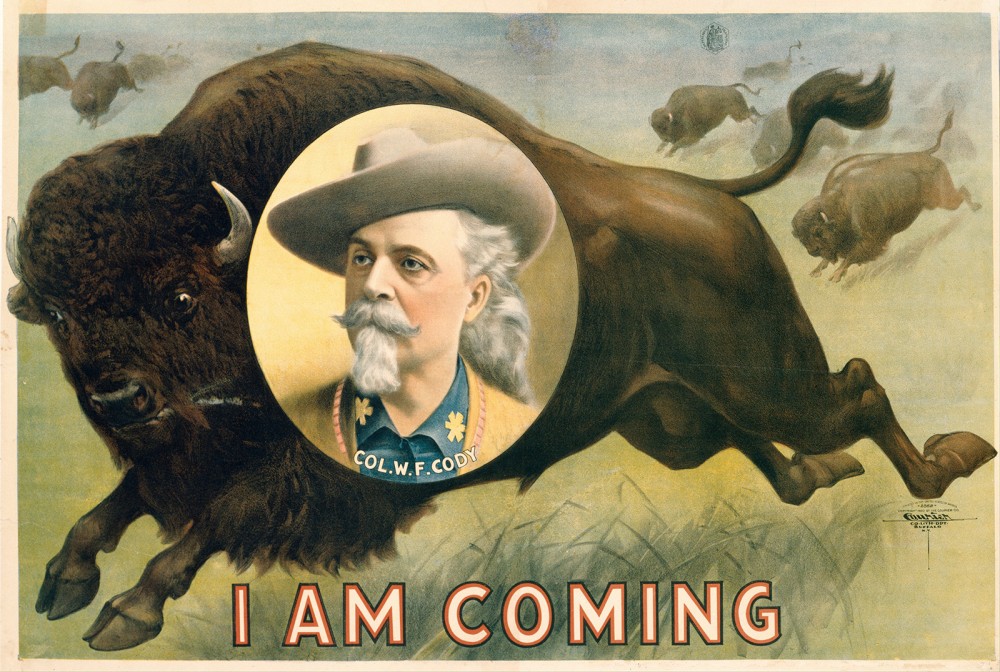
William Frederick "Buffalo Bill" Cody helped commercialize the cowboy lifestyle, building a mythology around life in the One-time West that produced big bucks for men like Cody. Courier Lithography Company, "'Buffalo Bill' Cody," 1900. Wikimedia.
Buffalo Bill, joined by shrewd business partners skilled in marketing, turned his shows into a sensation. But he was not alone. Gordon William "Pawnee Bill" Lillie, another popular Wild West showman, got his start in 1886 when Cody employed him every bit an interpreter for Pawnee members of the show. Lillie went on to create his own product in 1888, "Pawnee Beak's Historic Wild West." He was Cody's only real competitor in the business until 1908, when the two men combined their shows to create a new extravaganza, "Buffalo Nib's Wild West and Pawnee Neb's Swell Far East" (most people called information technology the "Ii Bills Show"). Information technology was an unparalleled spectacle. The cast included American cowboys, Mexican vaqueros, Native Americans, Russian Cossacks, Japanese acrobats, and an Australian aboriginal.
Cody and Lillie knew that Native Americans fascinated audiences in the Us and Europe, and both featured them prominently in their Wild Due west shows. Most Americans believed that Native cultures were disappearing or had already, and felt a sense of urgency to see their dances, hear their vocal, and be captivated by their bareback riding skills and their elaborate buckskin and feather attire. The shows certainly veiled the true cultural and celebrated value of so many Native demonstrations, and the Indian performers were curiosities to white Americans, but the shows were one of the few ways for many Native Americans to make a living in the late nineteenth century.
In an endeavor to entreatment to women, Cody recruited Annie Oakley, a female person sharpshooter who thrilled onlookers with her many stunts. Billed as "Little Sure Shot," she shot apples off her poodle'south caput and the ash from her married man's cigar, clenched trustingly between his teeth. Gordon Lillie'southward married woman, May Manning Lillie, also became a skilled shot and performed as "Earth'southward Greatest Lady Horseback Shot." Female sharpshooters were Wild Due west bear witness staples. As many as eighty toured the state at the shows' peak. But if such acts challenged expected Victorian gender roles, female person performers were typically careful to blunt criticism past maintaining their feminine identity—for example, by riding sidesaddle and wearing full skirts and corsets—during their acts.
The western "cowboys and Indians" mystique, perpetuated in novels, rodeos, and Wild West shows, was rooted in romantic nostalgia and, perchance, in the anxieties that many felt in the tardily nineteenth century'southward new seemingly "soft" industrial world of factory and office work. The mythical cowboy's "aggressive masculinity" was the seemingly perfect antidote for middle- and upper-form, city-habitation Americans who feared they "had become over-civilized" and longed for what Theodore Roosevelt called the "strenuous life." Roosevelt himself, a scion of a wealthy New York family and afterwards a popular American president, turned a brief tenure as a failed Dakota ranch possessor into a potent role of his political epitome. Americans looked longingly to the Westward, whose romance would continue to pull at generations of Americans.
Eight. The West as History: the Turner Thesis
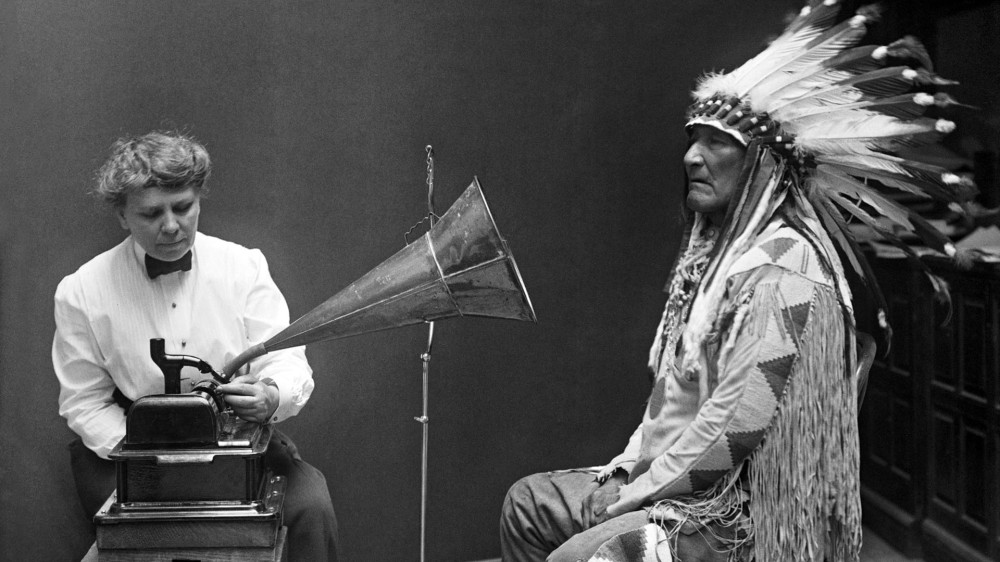
American anthropologist and ethnographer Frances Densmore records the Blackfoot primary Mountain Chief in 1916 for the Bureau of American Ethnology. Library of Congress.
In 1893, the American Historical Clan met during that yr's Globe's Columbian Exposition in Chicago. The young Wisconsin historian Frederick Jackson Turner presented his "frontier thesis," one of the nearly influential theories of American history, in his essay "The Significance of the Frontier in American History."
Turner looked back at the historical changes in the West and saw, instead of a tsunami of state of war and plunder and industry, waves of "civilization" that washed beyond the continent. A frontier line "between savagery and civilization" had moved west from the earliest English settlements in Massachusetts and Virginia across the Appalachians to the Mississippi and finally across the Plains to California and Oregon. Turner invited his audition to "stand at Cumberland Gap [the famous laissez passer through the Appalachian Mountains], and watch the procession of civilization, marching single file—the buffalo following the trail to the common salt springs, the Indian, the fur trader and hunter, the cattle-raiser, the pioneer farmer—and the borderland has passed by."28
Americans, Turner said, had been forced past necessity to build a rough-hewn civilization out of the frontier, giving the nation its exceptional hustle and its democratic spirit and distinguishing North America from the stale monarchies of Europe. Moreover, the style of history Turner chosen for was democratic every bit well, arguing that the work of ordinary people (in this example, pioneers) deserved the aforementioned written report as that of great statesmen. Such was a novel approach in 1893.
But Turner looked ominously to the time to come. The Census Bureau in 1890 had declared the frontier airtight. There was no longer a discernible line running due north to south that, Turner said, any longer divided civilization from savagery. Turner worried for the Usa' future: what would become of the nation without the safety valve of the frontier? It was a common sentiment. Theodore Roosevelt wrote to Turner that his essay "put into shape a good deal of thought that has been floating effectually rather loosely."29
The history of the West was fabricated by many persons and peoples. Turner'due south thesis was rife with faults, non just in its baldheaded Anglo-Saxon chauvinism—in which nonwhites fell before the march of "civilization" and Chinese and Mexican immigrants were invisible—simply in its utter inability to appreciate the touch of technology and regime subsidies and large-scale economic enterprises alongside the work of hardy pioneers. Nevertheless, Turner's thesis held an near canonical position among historians for much of the twentieth century and, more importantly, captured Americans' indelible romanticization of the Westward and the simplification of a long and complicated story into a march of progress.
9. Master Sources
1. Chief Joseph on Indian Affairs (1877, 1879)
A co-operative of the Nez Percé tribe, from the Pacific Northwest, refused to be moved to a reservation and attempted to abscond to Canada only were pursued by the U.S. Cavalry, attacked, and forced to return. The following is a transcript of Main Joseph's give up, as recorded past Lieutenant Wood, 20-first Infantry, acting aide-de-camp and interim adjutant-full general to Full general Oliver O. Howard, in 1877.
2. William T. Hornady on the Extermination of the American Bison (1889)
William T. Hornady, Superintendent of the National Zoological Park, wrote a detailed account of the about-extinction of the American bison in the tardily-nineteenth century.
3. Chester A. Arthur on American Indian Policy (1881)
The following is extracted from President Chester A. Arthur's First Almanac Bulletin to Congress, delivered Dec 6, 1881.
four. Frederick Jackson Turner, "Significance of the Frontier in American History" (1893)
Perhaps the most influential essay past an American historian, Frederick Jackson Turner'southward accost to the American Historical Clan on "The Significance of the Frontier in American History" defined for many Americans the human relationship between the frontier and American culture and contemplated what might follow "the closing of the frontier."
v. Turning Hawk and American Horse on the Wounded Knee Massacre (1890/1891)
On February xi, 1891, a Sioux delegation met with the Commissioner of Indian Affairs in Washington D.C. and gave their account of the Wounded Knee joint Massacre six weeks prior.
6. Laura C. Kellogg on Indian Educational activity (1913)
The United states used teaching to culturally assimilate Native Americans. Laura Cornelius Kellogg, an Oneida author, performer, and activist who helped found the Lodge of American Indians (SAI) in 1913, criticized the cultural chauvinism of American policy. Speaking to the SAI, she challenged her Indian audience to cover modern American democracy while maintaining their own identity.
7. Helen Hunt Jackson on a Century of Dishonor (1881)
In 1881, Helen Hunt Jackson published A Century of Dishonor, a history of the injustices visited upon Native Americans. Exposing the many wrongs perpetrated by her country, she hoped "to redeem the name of the U.s. from the stain of a century of dishonor."
8. Tom Torlino (1882, 1885)
Tom Torlino, a member of the Navajo Nation, entered the Carlisle Indian School, a Native American boarding school founded by the Usa government in 1879, on October 21, 1882 and departed on August 28, 1886. Torlino's educatee file contained photographs from 1882 and 1885.
9. Frances Densmore and Mountain Chief (1916)
American anthropologist and ethnographer Frances Densmore records the Blackfoot chief Mount Chief in 1916 for the Bureau of American Ethnology.
10. Reference Material
This affiliate was edited by Lauren Brand, with content contributions past Lauren Brand, Carole Butcher, Josh Garrett-Davis, Tracey Hanshew, Lindsay Stallones Marshall, Nick Roland, David Schley, Emma Teitelman, and Alyce Webb.
Recommended commendation: Lauren Brand et al., "Conquering the W," Lauren Brand, ed., in The American Yawp, eds. Joseph Locke and Ben Wright (Stanford, CA: Stanford University Press, 2018).
Recommended Reading
- Aarim, Najia. Chinese Immigrants, African Americans, and Racial Anxiety in the The states, 1848–1882. Champaign: University of Illinois Press, 2006.
- Andrews, Thomas. Killing for Coal: America's Deadliest Labor War. Cambridge, MA: Harvard University Press, 2009.
- Brown, Dee. Bury My Heart at Wounded Knee: An Indian History of the American W. New York: Holt, Rinehart and Winston, 1970.
- Cahill, Cathleen. Federal Fathers and Mothers: A Social History of the Us Indian Service, 1869–1933. Chapel Hill: Academy of North Carolina Press, 2011.
- Cronon, William. Nature's Metropolis: Chicago and the Great Due west. New York: Norton, 1991.
- Estes, Nick. Our History is the Time to come: Standing Rock Versus the Dakota Access Pipeline, and the Long Tradition of Ethnic Resistance. New York: Verso, 2019.
- Gordan, Linda. The Bully Arizona Orphan Abduction. Cambridge, MA: Harvard Academy Press, 1999.
- Hämäläinen, Pekka. The Comanche Empire. New Haven, CT: Yale University Printing, 2008.
- Hine, Robert V. The American West: A New Interpretive History. New Haven, CT: Yale Academy Press, 2000.
- Huhndorf, Shari Thou. Going Native: Indians in the American Cultural Imagination. Ithaca, NY: Cornell University Press, 2001.
- Isenberg, Andrew C. The Devastation of the Bison: An Ecology History, 1750–1920. Cambridge, United kingdom: Cambridge University Press, 2000.
- Jacobs, Margaret D. White Mother to a Nighttime Race: Settler Colonialism, Maternalism, and the Removal of Indigenous Children in the American W and Australia, 1880–1940. Lincoln: University of Nebraska Press, 2009.
- Johnson, Benjamin Heber. Revolution in Texas: How a Forgotten Rebellion and Its Bloody Suppression Turned Mexicans into Americans. New Haven, CT: Yale University Press, 2003.
- Kelman, Ari. A Misplaced Massacre: Struggling over the Memory of Sand Creek. Cambridge, MA: Harvard University Printing, 2013.
- Krech, Shepard. The Ecological Indian: Myth and History. New York: Norton, 1999.
- Limerick, Patricia Nelson. The Legacy of Conquest: The Unbroken Past of the American W. New York: Norton, 1987.
- Marks, Paula Mitchell. In a Barren Land: American Indian Dispossession and Survival. New York: Morrow, 1998.
- Montejano, David. Anglos and Mexicans in the Making of Texas, 1836–1986. Austin: Academy of Texas Press, 1987.
- Pascoe, Peggy. Relations of Rescue: The Search for Female Moral Authority in the American Westward, 1874–1939. New York: Oxford University Press, 1990.
- Prucha, Francis Paul. The Not bad Father: The United States Authorities and the American Indians. Lincoln: University of Nebraska Press, 1984.
- Schulten, Susan. The Geographical Imagination in America, 1880–1950. Chicago: University of Chicago Press, 2001.
- Shah, Nayan. Stranger Intimacy: Contesting Race, Sexuality, and the Constabulary in the North American West. Berkeley: Academy of California Press, 2011.
- Smith, Henry Nash. Virgin Country: The American West as Symbol and Myth. New York: Vintage Books, 1957.
- Taylor, Quintard. In Search of the Racial Frontier: African Americans in the American Due west, 1528–1990. New York: Norton, 1999.
- Warren, Louis South. Buffalo Bill's America: William Cody and the Wild Due west Show. New York: Knopf, 2005.
- White, Richard. "Information technology'southward Your Misfortune and None of My Own": A New History of the American Westward. Norman: University of Oklahoma Press, 1991.
Notes
- Based on U.Southward. Census figures from 1900. See, for instance, Donald Lee Parman, Indians and the American W in the Twentieth Century (Bloomington: Indiana University Press, 1994), nine. [↩]
- Rodman Westward. Paul, The Mining Frontiers of the W, 1848–1880 (New York: Holt, Rinehart and Winston, 1963); Richard Lingenfelter, The Hard Rock Miners (Berkeley: University of California Press, 1979). [↩]
- Richard White, It's Your Misfortune and None of My Own: A New History of the American Due west (Norman: University of Oklahoma Press, 1991), 216–220. [↩]
- Matthew Bowman, The Mormon People: The Making of an American Faith (New York: Random House, 2012). [↩]
- White, It'south Your Misfortune, 142–148; Patricia Nelson Composition, The Legacy of Conquest: The Unbroken Past of the American West (New York: Norton, 1987), 161–162. [↩]
- White, It's Your Misfortune; Limerick, Legacy of Conquest. [↩]
- John D. Hicks, The Populist Revolt: A History of the Farmers' Alliance and the People'due south Party (Minneapolis: University of Minnesota Printing, 1931), half-dozen. [↩]
- Robert Utley, The Indian Frontier 1846–1890 (Albuquerque: University of New United mexican states Press, 1984), 76. [↩]
- Jeffrey Ostler, The Plains Sioux and U.Southward. Colonialism from Lewis and Clark to Wounded Human knee (New York: Cambridge University Press, 2004). [↩]
- Elliott West, The Contested Plains: Indians, Goldseekers, and the Rush to Colorado (Lawrence: Kansas University Printing, 1998. [↩]
- Francis Paul Prucha, The Bully Begetter: The Us Government and the American Indians (Lincoln: University of Nebraska Press, 1995), 482. [↩]
- Bureau of Indian Affairs, Annual Written report of the Commissioner of Indian Affairs to the Secretarial assistant of the Interior (Washington, DC: U.S. Government Press Office, 1875), 221. [↩]
- For the Comanche, come across especially Pekka Hämäläinen, The Comanche Empire (New Haven, CT: Yale Academy Press, 2008). [↩]
- Ostler, The Plains Sioux and U.S. Colonialism . [↩]
- Utley, The Indian Frontier . [↩]
- Boyd Cothran, Remembering the Modoc War: Redemptive Violence and the Making of American Innocence (Chapel Loma: Academy of North Carolina Press, 2014). [↩]
- Report of the Secretary of State of war, Beingness Function of the Message and Documents Communicated to the Two Houses of Congress, Beginning of the Second Session of the Forty-Fifth Congress. Volume I (Washington, DC: U.Southward. Regime Printing Office 1877), 630. [↩]
- Alfred D. Chandler Jr. The Visible Paw: The Managerial Revolution in American Business (Cambridge, MA: Belknap Press, 1977). [↩]
- Richard White, Railroaded: The Transcontinentals and the Making of Modern America (New York: Norton, 2011), 107. [↩]
- Walter Licht, Working on the Railroad: The Organization of Work in the Nineteenth Century (Princeton, NJ: Princeton University Press, 2014), chap. 5. [↩]
- John F. Stover, The Routledge Historical Atlas of the American Railroads (New York: Routledge, 1999), fifteen, 17, 39, 49. [↩]
- Richard W. Slatta, Cowboys of the Americas (New Oasis, CT: Yale University Press, 1994). [↩]
- Limerick, Legacy of Conquest, 195–199; White, It'due south Your Misfortune, 115. [↩]
- On the Ghost Dance Organized religion, see peculiarly Louis S. Warren, God'southward Red Son: The Ghost Dance Organized religion and the Making of Modern America(New York: Basic, 2017). [↩]
- Run across, for instance, Oliver Knight, Following the Indian Wars (Norman: University of Oklahoma Press, 1960). [↩]
- Dee Brown, Bury My Heart at Wounded Human knee: An Indian History of the American West (New York: Holt, Rinehart and Winston, 1970). [↩]
- Joy Due south. Kasson, Buffalo Beak'due south Wild West: Celebrity, Memory, and Popular History (New York: Macmillan, 2001). [↩]
- Frederick Jackson Turner, The Frontier in American History (New York: Holt, 1921), 12. [↩]
- Kasson, Buffalo Pecker's Wild W, 117. [↩]
Source: https://www.americanyawp.com/text/17-conquering-the-west/
0 Response to "University of Limerick Robes for History of Family"
แสดงความคิดเห็น